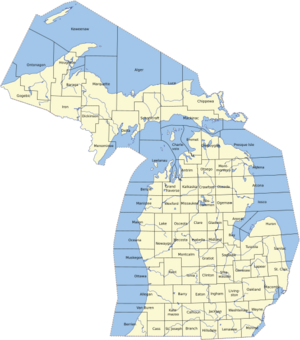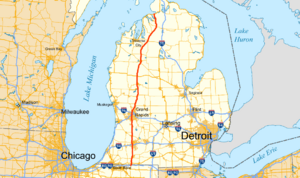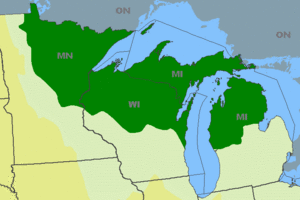Northern Michigan facts for kids
Quick facts for kids
Northern Michigan
Northern Lower Michigan
|
|
|---|---|
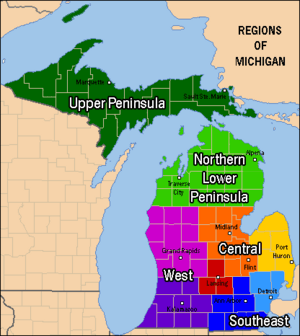
Northern Michigan is highlighted in light green.
|
|
| Country | United States |
| State | Michigan |
| Population | |
| • Total | 506,658 |
| Time zone | Eastern: UTC −5/−4 |
Northern Michigan, also called Northern Lower Michigan, is a beautiful region in the U.S. state of Michigan. Many people from southern Michigan and other states call it "up north." It's a popular place for tourists. You'll find small cities, huge forests, many lakes and rivers, and lots of Great Lakes shoreline here. The region has a large population of visitors, especially during summer. Northern Lower Michigan is different from the Upper Peninsula (the "U.P."), even though the U.P. is also in northern Michigan. About 506,658 people live in the 21 northernmost counties of the Lower Peninsula of Michigan.
Contents
- Exploring Northern Michigan's Geography
- Counties of Northern Michigan
- Cities and Towns in Northern Michigan
- Fun Things to Do in Northern Michigan (Tourism)
- A Look at Northern Michigan's History
- Getting Around Northern Michigan (Transportation)
- Plants and Animals of Northern Michigan (Flora and Fauna)
- Northern Michigan's Economy
- Learning in Northern Michigan (Education)
- Images for kids
Exploring Northern Michigan's Geography
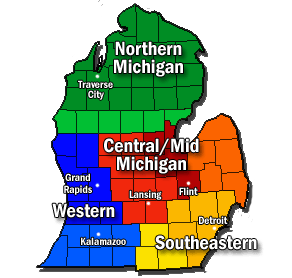
Northern Michigan is known for its rolling hills, sandy coastal dunes along the Great Lakes, and many inland lakes and rivers. Large forests cover much of the land. The 45th parallel, which is halfway between the Equator and the North Pole, crosses this region. You can find signs marking this line in places like Traverse City and Gaylord.
Understanding the Boundaries
The exact southern edge of Northern Michigan isn't perfectly clear. Some people think it starts just north of cities like Flint and Grand Rapids. Others believe it begins further north, past Mount Pleasant, in the "fingers" of Michigan's mitten shape.
Northern Michigan vs. the Upper Peninsula
Even though the Upper Peninsula of Michigan is geographically north, it's usually seen as a separate region. People in Michigan often call it the "U.P." The two regions are connected by the amazing 5-mile long Mackinac Bridge.
Climate and Weather Patterns
Northern Michigan experiences all four seasons, sometimes with extreme temperatures. Summers can be warm and humid, while winters can be very cold with lots of snow. The region is famous for its stunning "fall colors" in autumn.
Heavy snow often falls in areas called "snow belts." This happens because of the "lake effect" from Lake Michigan. For example, Gaylord gets about 141 inches of snow each year, while Harrisville gets around 52 inches. The highest and lowest temperatures ever recorded in Michigan happened here. The record high was 112°F (44°C) in Mio in 1936. The record low was -51°F (-46°C) in Vanderbilt in 1934.
Population and Early Settlers
The northern 21 counties of Michigan's Lower Peninsula are home to over 500,000 people. Many different groups settled here over time. These included people from New England and immigrants from Ireland, Germany, and Poland. The Odawa nation also lives in this area, with Native American reservations at Mount Pleasant and on the Leelanau Peninsula.
Counties of Northern Michigan
Northern Michigan includes 21 counties. They are:
- Alcona County, Michigan
- Alpena County, Michigan
- Antrim County, Michigan
- Benzie County, Michigan
- Charlevoix County, Michigan
- Cheboygan County, Michigan
- Crawford County, Michigan
- Emmet County, Michigan
- Grand Traverse County, Michigan
- Iosco County, Michigan
- Kalkaska County, Michigan
- Leelanau County, Michigan
- Manistee County, Michigan
- Missaukee County, Michigan
- Montmorency County, Michigan
- Ogemaw County, Michigan
- Oscoda County, Michigan
- Otsego County, Michigan
- Presque Isle County, Michigan
- Roscommon County, Michigan
- Wexford County, Michigan
Cities and Towns in Northern Michigan
Here are some of the cities, villages, and communities you can find in Northern Michigan:
- Alpena
- Atlanta
- Boyne City
- Cadillac
- Charlevoix
- Cheboygan
- East Jordan
- East Tawas
- Elk Rapids
- Empire
- Frankfort
- Gaylord
- Grayling
- Harbor Springs
- Harrisville
- Houghton Lake
- Indian River
- Interlochen
- Kalkaska
- Kingsley
- Lake Ann
- Lake Leelanau
- Lewiston
- Lincoln
- Ludington
- Mackinac Island
- Mackinaw City
- Manistee
- Mio
- Northport
- Omer
- Onaway
- Oscoda
- Pellston
- Petoskey
- Posen
- Rogers City
- Roscommon
- Rose City
- Scottville
- Standish
- Tawas City
- Thompsonville
- Traverse City
- Vanderbilt
- West Branch
- Wolverine
Fun Things to Do in Northern Michigan (Tourism)
Northern Michigan is a huge tourist spot, offering activities all year round!
Summer Adventures
In summer, people love to go boating, golfing, and camping. You can also enjoy sailing, kayaking, canoeing, bird watching, biking, and horseback riding. The region has many Michigan state parks and protected areas like the Huron National Forest, Manistee National Forest, and Sleeping Bear Dunes National Lakeshore.
Many families from southern Michigan and Chicago have summer homes here. Popular tourist towns on the west side, along Lake Michigan, include Traverse City, Charlevoix, Petoskey, and Manistee. These towns have sandy beaches and warm bays. The area also has a growing wine district.
At the very top of the Lower Peninsula, you'll find Mackinaw City and Mackinac Island. The island is located between the Lower and Upper Peninsulas.
The northeastern side, along Lake Huron, is less crowded but still offers great vacation spots. These include Oscoda, Harrisville, and Alpena.
Inland, there are many cities and lakes to explore. Cities like Cadillac, Grayling, and Gaylord are popular summer destinations. Large inland lakes like Houghton Lake and Torch Lake are also great for vacations.
Winter Fun and Other Seasons
Northern Michigan is also a winter wonderland! You can go downhill skiing at resorts like Boyne Mountain and Crystal Mountain. Cross-country skiing is also very popular, especially near Frederic.
Snowmobiling is a huge winter activity, with hundreds of miles of groomed trails. Ice fishing is also popular. Houghton Lake hosts "Tip-up Town," a unique festival where a whole village is built on the frozen lake!
In the fall, visitors enjoy harvest festivals, special beer and wine events, and "fall color tours" to see the beautiful changing leaves. Hunting is also a big pastime in the fall.
Other Cool Places to Visit
- Pierce Stocking Scenic Drive: A beautiful drive with amazing views of the dunes.
- Thunder Bay National Marine Sanctuary: Explore shipwrecks underwater.
- Mackinac Bridge: Walk or bike across this iconic bridge.
- Fort Michilimackinac: A historic fort where you can learn about early life.
- Lumberman's Monument: Honors the lumberjacks who worked in the area. It's along the River Road National Scenic Byway.
- Hartwick Pines State Park: See a rare old-growth forest of huge pine trees. It's like stepping back in time to how Michigan looked before logging.
- Lighthouses: There are many historic lighthouses along the Great Lakes coasts, offering great views and history.
Festivals and Events
Northern Michigan hosts many fun annual festivals:
| Festival Name | Festival Location | Remarks |
|---|---|---|
| AlpenFest | Gaylord | A fun festival with a run/walk. |
| Au Sable River Canoe Marathon | Grayling to Oscoda | A challenging canoe race, one of the top in the U.S. |
| Michigan Brown Trout Festival | Alpena | A fishing festival for brown trout. |
| Cadillac Chestnut Harvest Festival | Cadillac | Celebrates the chestnut harvest every October. |
| Charlevoix Waterfront Art Fair | Charlevoix | An art fair by the water in August. |
| National Coho Salmon Festival | Honor | Celebrates the coho salmon. |
| Great Lakes Lighthouse Festival | Alpena | A unique festival celebrating lighthouses. |
| Mackinac Island Fudge Festival | Mackinac Island | A sweet festival celebrating fudge. |
| Mackinac Island Lilac Festival | Mackinac Island | Celebrates the beautiful lilac flowers. |
| National Cherry Festival | Traverse City | A famous festival celebrating cherries. |
| National Morel Mushroom Festival | Boyne City | Celebrates the tasty morel mushrooms. |
| National Trout Festival | Kalkaska | Held at the end of April, celebrating trout fishing. |
| Paul Bunyan Festival | Oscoda | Honors the legendary lumberjack, Paul Bunyan. |
| Posen Potato Festival | Posen | A festival celebrating potatoes. |
| Tip-Up Town | Houghton Lake | A big ice fishing and winter sports festival on the frozen lake. |
| Traverse City Film Festival | Traverse City | A popular film festival. |
| Venetian Festival | Charlevoix | A beautiful festival with boats and lights. |
A Look at Northern Michigan's History
Northern Michigan has a rich history, from ancient Native American tribes to the rise of tourism.
Early Native American Life
For many years before Europeans arrived, Native American tribes lived in Northern Michigan. They moved with the seasons. The Odawa nation, for example, lived in Emmet County. The Anishinaabe people (including the Ojibwe, Potawatomi, and Odawa), known as the "Council of Three Fires," were the main tribes in the area around the Straits of Mackinac.
French and British Influence (1600s-1700s)
French explorers and missionaries came to the Great Lakes region in the 1600s. They set up the North American fur trade with Native American tribes. Father Marquette started a mission in St. Ignace in 1671. He explored and mapped Lake Michigan. Later, the French built Fort Michilimackinac on the southern side of the Straits. This fort became a key trading post.
After the French and Indian War in the 1760s, the British took control of the Straits of Mackinac. However, Native Americans resisted, and many British soldiers at Fort Michilimackinac were killed in Pontiac's War. The British later built a stronger fort, Fort Mackinac, on Mackinac Island.
Becoming Part of the United States (Late 1700s - Early 1800s)
The United States officially gained control of the Straits area from Britain in 1783. But British forces didn't leave until 1796. Mackinac Island became a major center for the American fur trade.
In 1836, a treaty with Native American tribes opened up much of Northern Michigan for settlement. This led to more people moving to the area.
Growth and Industry (Mid-1800s)
As more people arrived, coastal towns like Manistee and Traverse City grew. The Homestead Act of 1862 encouraged many to settle here.
The lumber industry became huge in the late 1800s. Trees were cut down and floated down rivers to mills. Northern Michigan produced more lumber than any other state! Commercial fishing also boomed, especially around Beaver Island. However, overfishing led to a decline in fish populations.
Railroads arrived in the 1870s, connecting Northern Michigan to bigger cities in the south. This helped transport lumber and other goods. Sadly, the passenger pigeon, once common, was hunted to extinction during this time.
The Rise of Resorts (Late 1800s - 1900s)
As logging slowed down, Northern Michigan became known as a resort destination. Wealthy families built summer homes. Mackinac National Park was even created in 1875, becoming the second National Park in the U.S.
Sport fishing became popular, especially on the Au Sable River. The state even started stocking rivers with fish like trout to support the industry.
In the 1900s, many areas were turned into National Forests and State Parks to protect the land. Ski resorts also opened, like Hanson Hills in Grayling in 1929.
As cars became more common, passenger train travel declined. Local groups started promoting Northern Michigan with festivals and attractions, which still draw visitors today.
Getting Around Northern Michigan (Transportation)
You can travel in Northern Michigan by air, water, or land.
Travel by Air
Several airports serve the region, including Pellston Regional Airport, Traverse City Cherry Capital Airport, and Alpena County Regional Airport. These airports connect Northern Michigan to other parts of the country.
Travel by Water
Ferries are still an important way to travel here:
- The SS Badger carferry takes cars and passengers across Lake Michigan from Ludington to Wisconsin.
- Ferries connect Charlevoix to Beaver Island.
- Lake ferries take passengers to Mackinac Island from Mackinaw City or St. Ignace.
- You can take a ferry to Charity Island in Saginaw Bay.
- The Kristen D ferry travels between Cheboygan and Bois Blanc Island.
The biggest bridge in Northern Michigan is the Mackinac Bridge, connecting the Lower and Upper Peninsulas.
Travel by Land (Roads)
Most people travel by car in Northern Michigan. Major highways include:
 I-75: Runs from the Flint area up to the Mackinac Bridge.
I-75: Runs from the Flint area up to the Mackinac Bridge. US 10: Connects Ludington on Lake Michigan to Bay City.
US 10: Connects Ludington on Lake Michigan to Bay City. US 23: Follows the Lake Huron shoreline.
US 23: Follows the Lake Huron shoreline. US 31: Parallels the Lake Michigan shore from Ludington north to Mackinaw City.
US 31: Parallels the Lake Michigan shore from Ludington north to Mackinaw City. US 131: A main north-south highway, connecting cities like Kalkaska and Petoskey.
US 131: A main north-south highway, connecting cities like Kalkaska and Petoskey. M-22: A scenic drive along the Lake Michigan shoreline and the Sleeping Bear Dunes National Lakeshore.
M-22: A scenic drive along the Lake Michigan shoreline and the Sleeping Bear Dunes National Lakeshore. M-72: Crosses the Lower Peninsula from Empire to Harrisville.
M-72: Crosses the Lower Peninsula from Empire to Harrisville.
Plants and Animals of Northern Michigan (Flora and Fauna)
Northern Michigan is home to a wide variety of plants and animals.
Common Plants and Trees
The forests here have many types of trees, including maple, birch, oak, pine, and beech. You'll also find ferns, milkweed, and trillium flowers. Marram grass grows on the beaches.
Mammals You Might See
Common mammals include white-tailed deer, fox, raccoons, and rabbits. You might also spot black bears, elk, coyotes, and bobcats. While rare, some people report seeing mountain lions.
Birds of the Region
Many birds live in Northern Michigan, such as ducks, seagulls, wild turkey, great blue herons, northern cardinals, and blue jays. You might see Canada geese flying overhead. Unique birds found here include the spruce grouse and the Kirtland's warbler, an endangered species that lives in the Au Sable State Forest.
Insects and Reptiles
You'll find common insects like ladybugs, crickets, dragonflies, and mosquitoes. A very rare insect, the Hungerford's crawling water beetle, lives in only a few places in the world, and four of them are in Northern Michigan!
There are no fatally poisonous snakes in Northern Michigan. The Eastern Massasauga Rattlesnake lives here but is not common. Its bite is not usually fatal but needs medical attention. Other snakes include the common garter snake and eastern milk snake. You'll also see frogs, toads, salamanders, and small turtles.
State Forests and Protected Areas
Michigan has the largest state forest system in the U.S., covering 3.9 million acres. Northern Michigan includes parts of:
- Mackinaw State Forest
- Pere Marquette State Forest
- Au Sable State Forest
Large parts of the Manistee National Forest and Huron National Forest are also here. The Nordhouse Dunes Wilderness is a special area with huge sand dunes along Lake Michigan. Eight islands in Lake Michigan and Lake Huron are part of the Michigan Islands National Wildlife Refuge.
Northern Michigan's Economy
The economy in Northern Michigan is smaller than in southern Michigan. It relies a lot on seasonal jobs and tourism.
Tourism and Real Estate
Tourism is a huge part of the economy. Many people buy real estate, like condos and summer homes, here. This means the economy can be affected by how well other industries, like the automobile industry, are doing in southern Michigan.
Farming and Industry
Farming is limited by the climate, but you'll find potato and dry bean farms in the east. In the west, near Grand Traverse Bay, the special microclimate helps grow wine grapes, vegetables, and cherries. This area is famous for its cherries!
There isn't a lot of heavy industry. However, there's a big cement plant in Alpena and a huge limestone quarry in Rogers City. Morton Salt also has a large salt plant in Manistee.
Northern Michigan also has significant natural gas reserves from the Antrim shale formation.
Military Presence
The military has a presence in Northern Michigan:
- Alpena Combat Readiness Training Center in Alpena, Michigan is run by the Air National Guard.
- Camp Grayling near Grayling, Michigan is the largest military training site east of the Mississippi River. It's used by all branches of the U.S. National Guard and other forces. Much of the land is open to the public for recreation when not in use for training.
- The United States Coast Guard has stations in Charlevoix and Traverse City for search and rescue.
Learning in Northern Michigan (Education)
Northern Michigan has several places for learning:
- Interlochen Center for the Arts: A famous arts school and summer camp near Traverse City.
- Community colleges: North Central Michigan College, Alpena Community College, Kirtland Community College, West Shore Community College, and Northwestern Michigan College.
- Great Lakes Maritime Academy: The only U.S. maritime academy on freshwater, located at Northwestern Michigan College.
- Ferris State University: A four-year university in Big Rapids.
- University Centers: Northwestern Michigan College partners with other universities like Michigan State and Central Michigan to offer bachelor's and master's degrees locally.
Images for kids
-
Traverse City, the largest city in Northern Michigan
-
Alpena County Courthouse in Alpena, the region's second largest city
-
Wexford County Courthouse in Cadillac, the third largest city in Northern Michigan
-
The Manistee River in Manistee, the fourth-largest city in the region.


